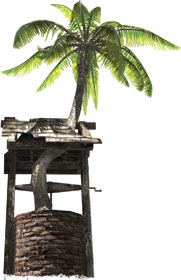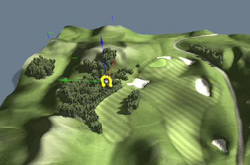Forces
“Forces” are scene objects that can be used to push, pull, gnarl, twist, curl, or obstruct parts of the tree.
Overview
Forces are powerful modeling tools that can manipulate spine growth in ways that would be impossible without them. There are many types of forces, each with different capabilities. Since forces are world-space objects and not bound to the tree hierarchy, they can be transformed (moved, rotated, or scaled) with manipulators in the 'Tree Window'. Use the toolbar icons to change the manipulation mode.
Adding Forces
To add a force to the scene, right-click in the tree window or use the “+” toolbar button and select “Add force”. Forces can also be added from the Generation Editor's “Forces” icon. If one or more generators or nodes are selected before the force is added, the added force will be automatically enabled on the selection (see “Allowing forces” below).
Deleting forces is as easy as selecting it and pressing the delete key.
Allowing Forces
After a force has been added to the scene, it must be 'Enabled' on either a generator or node level to have an effect on them. This is set in the “Forces” group in the 'Property Editor', which has a checkbox for every force currently in the scene. For instance, to have one force act on the trunk (e.g., pull the tree left) and a different force act only on its child branches (e.g., pull the child nodes right).
There is also an over-arching Allow forces property that will toggle on or off all forces collectively for the selected generators or nodes.
Disabling Forces
Forces themselves may be enabled or disabled independently of whether they are “allowed” or not. This is accomplished with the 'Enabled' property on the force object itself. Disabled forces are shown as dark gray.
Renaming Forces
Same type are present, new names are enumerated (e.g. “Magnet 1”). To make it easier to tell them apart, forces can be manually renamed. Select a force so the force properties appear and press “F2”to rename the force.
Localizing the Area of Influence
Since forces are world-space objects, they can be freely moved around in the scene. By enabling Attenuation on the force object's properties, the area of affect will be limited to a radius around the force object. This lets you have a force only affect a very specific part of the tree, such as only branches over the negative 'XY' quadrant.
Force Types
There are several types of forces available, each having their own unique affect on the tree shape. Any force can have its type changed by selecting a different type on the force's properties. The available types are:
![]() Direction
Direction
Spines grow in the direction that the arrow points.
![]() Magnet
Magnet
Spines converge on a single point at the center of the force.
![]() Gnarl
Gnarl
Spines twist around a world-space vector that is determined by the force's rotation.
![]() Twist
Twist
Spines twist along their local up vectors and are altered by the force's rotation.
![]() Curl
Curl
Spines curl inward on themselves in a direction determined by the force's rotation.
![]() Planar
Planar
Spines grow along a 2D plane determined by the force's rotation.
![]() Mesh
Mesh
Spines grow toward or around an arbitrary mesh object. See thee mesh forces section below for more details.
![]() Return
Return
Standard and subdivision branches will return to their original growth direction. Use this to keep wildly disturbed, jinked, twisted, curled, or gnarled branches under some control.
![]() Season light
Season light
Leaves change season sooner based on the how much they are growing toward the position of this force object. Fine tune the behavior with the leaf generator's 'Anatomical sensitivity' property.
Mesh Forces
 When using mesh forces, you'll need to load in a mesh asset for it to be visible. Once a mesh has been loaded your tree can be set to interact with it. Below are a couple of brief videos showing how to involve a mesh force with a tree model.
When using mesh forces, you'll need to load in a mesh asset for it to be visible. Once a mesh has been loaded your tree can be set to interact with it. Below are a couple of brief videos showing how to involve a mesh force with a tree model.
![]() Watch the 'Mesh Force Walk Through' and the 'Mesh Force Examples' videos by clicking this link.
Watch the 'Mesh Force Walk Through' and the 'Mesh Force Examples' videos by clicking this link.
http://www.speedtree.com/demo-videos.php
Assigning Mesh Assets
To load arbitrary mesh objects into the scene, use the Mesh Asset bar. Import any 3D model in 'STM', 'OBJ', 'FBX', 'DAE', or '3DS' formats. We've provided a few sample meshes in the [install directory]/Samples/Meshes folder. Once loaded, assign the model to the force object's Mesh property.
Mesh Force Actions
Mesh forces can have various affects on the tree. Spines can be attracted to or repelled from the mesh, and spines that collide with the mesh force can either be obstructed by the mesh or become pruned at the point of intersection. See the context-sensitive help for detailed descriptions of all mesh force actions.
Including the Mesh In The Tree Model
The Include in model property allows a mesh force to be included as part of the tree model. When the SPM file is loaded into the Compiler and converted into a real-time model (SRT), the mesh object will appear with the tree when rendered using the SDK. Included meshes can also be exported as 'FBX' or 'OBJ'.
Using Forces With Zones
When world building with zones, forces can be used to influence the growth patterns of the nodes coming off of the zone. For instance, applying a directional force to a zone will only allow growth from faces that closely match the direction that the force is pointing. Use the Influence of forces property to adjust the effect.
